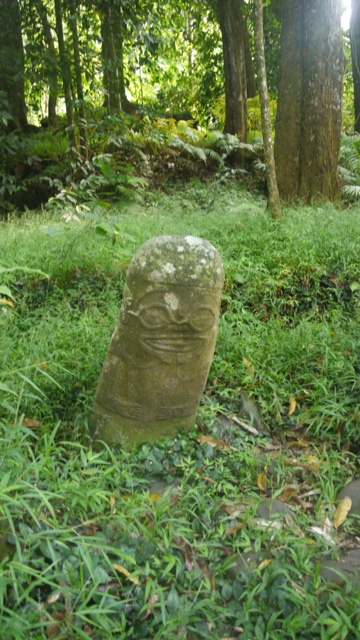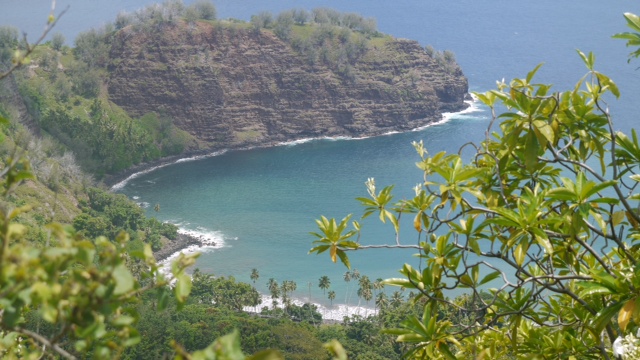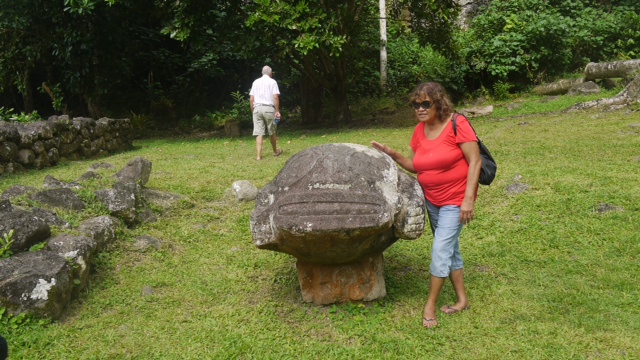Hiva Oa Island Tour

Seaduced
John & Jane Craven
Thu 20 Mar 2014 01:49
We did a day trip here to the other side of the island, to Paumau, to see the ancient Tiki site. It is only about 30miles away in a straight line, but the roads are far from direct! It was one long 2.5 hour journey around hairpin bend after hairpin bend and very steep hills, the guide told us that she has to change her car every 5 years as they don't last longer than that.
The guide was very informative and gave us a lot of information about the island and the culture. The local people are a melting pot of various cultures, with Asian and South American influences being very obvious. The original explorers set off from places like the Philippines and Taiwan to go towards Polynesia with their small outrigger boats packed with breadfruit, coconuts, pigs and chickens to find a new land. This happened over 1000 years before any Europeans managed to find Polynesia. The first Europeans to arrive were the English, the Spanish, and then the French. As is often the case, 'ownership' of the islands changed hands many times over the next few years. One reason for this was that while the English had arrived first, they were still on their way home when the French arrived! So nobody knew the islands had been found.
The French eventually took control once and for all in the 1800's. The culture was suppressed by the arrival of French Catholic missionaries who were generally appalled by the way people were living here, enjoying what they felt was a very debauched lifestyle! Just about every tradition they had was outlawed, including tattooing, dancing and music. Since 1987 however, the culture has been enjoying a massive revival and the traditions are making a definite comeback. One tradition which certainly surprised us relates to the tattoos women wear on their hands. If a child is born in the hours of darkness, that child is deemed sacred, and no women without her hands and arms tattooed can touch it's head, on pain of death!
One part of the culture that was outlawed was the use of Tikis, scared statues depicting tribal Chiefs and Queens. Each village was basically a tribe and throughout the island there have been up to 23 tribes at any one time. There are a few Tiki sites in Hiva Oa, the most important being Pauma'u, which is where we were headed.
Pauma'u is home to a restored, sacred Tiki site, over 1000 years old. There are a series of platforms and 5 large tiki statues, the tallest of which is over 2m high. This is also the tallest Tiki in Polynesia. His name is Taka'i, named after a warlord known for his strength. When the Chiefs and Queens died they were brought to the site to be prepared for burial. They were mummified and the remains hidden in grottos in the mountains behind the site. Certain areas were off limits to women, and the whole site was only accessible to the most important people in the tribe.
This was the first small Tiki that we saw, it depicts a male Chief. This was well hidden down a forest track which was quite difficult to find.
John and I with the Tiki
A view across one of the stunning island bays
Pauma'u Tiki site
This is Freida, our guide with one of the statues. This has a craving of a llama on the side which is supposed prof that some of the original inhabitants of the islands came from South America.
Another stunning island view - we had a lot of these on the way to Pauma'u
Me with the tallest Tiki
There is also a very tragic story relating to one of the uninhibited islands here, just south of Hiva Oa. Mohane was inhabited up to 200 years ago. As part of a celebration, the people gathered in one of the grottos for dancing and music. The drumming was so loud that it brought the mountain down on top of them and the whole population, apart from a few elders who had decoded not to attend the celebration were buried alive. The worst part of it all was that the drums were heard for 15 days after the mountain fell in, but nobody was able to rescue the trapped people. The island has been uninhibited since.
As you travel round the island, the gardens are beautiful and full of trees and plants producing all manner of fruit and vegetables. Everyone here grows their own, almost entirely for their own consumption. As the locals don't need to buy fruit and vegetables, the shops sell very little of it, just some carrots, if you're lucky although they did seem to have an abundance of leeks! Fruit can be bought at a small stall near the ARC office, set up for our benefit, or in some islands you can trade other items for fruit. Trading isn't so prevalent here as there are shops etc on the island, but in the smaller islands it will almost certainly be one way of getting your fruit. I will let you know how we get on.....
Sent from my iPad






